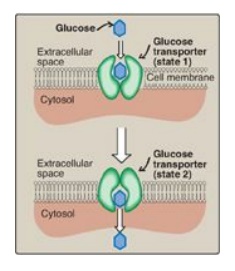Transport of Glucose into Cells
| Home | | Biochemistry |Chapter: Biochemistry : Introduction to Metabolism and Glycolysis
Glucose cannot diffuse directly into cells but enters by one of two transport mechanisms: a Na+ -independent, facilitated diffusion transport system or an ATP-dependent Na+-monosaccharide cotransport system.
TRANSPORT OF GLUCOSE INTO CELLS
Glucose cannot diffuse directly into cells but enters by one of two transport mechanisms: a Na+ -independent, facilitated diffusion transport system or an ATP-dependent Na+-monosaccharide cotransport system.
A. Sodium-independent facilitated diffusion transport system
This system is mediated
by a family of 14 glucose transporters found in cell membranes. They are
designated GLUT-1 to GLUT-14 (glucose transporter isoforms 1– 14). These
monomeric protein transporters exist in the membrane in two conformational states
(Figure 8.10). Extracellular glucose binds to the transporter, which then
alters its conformation, transporting glucose across the cell membrane.

Figure 8.10 Schematic representation of the facilitated transport of glucose through a cell membrane. [Note: Glucose transporter proteins are monomeric and contain 12 transmembrane β helices.]
1. Tissue specificity of glucose transporter gene
expression: The
GLUTs display a tissue-specific pattern of expression. For example, GLUT-3 is
the primary glucose transporter in neurons. GLUT-1 is abundant in erythrocytes
and the blood–brain barrier but is low in adult muscle, whereas GLUT-4 is
abundant in muscle and adipose tissue. [Note: The number of GLUT-4 transporters
active in these tissues is increased by insulin. (See : for a discussion of
insulin and glucose transport.)] GLUT-2 is abundant in liver, kidney, and β
cells of the pancreas. The other GLUT isoforms also have tissue-specific
distributions.
2. Specialized functions of glucose transporter isoforms: In facilitated diffusion, transporter-mediated glucose movement is down a concentration gradient (that is, from a high glucose concentration to a lower one and, therefore, does not require energy). For example, GLUT-1, GLUT-3, and GLUT-4 are primarily involved in glucose uptake from the blood. In contrast, GLUT-2, in the liver and kidney, can either transport glucose into these cells when blood glucose levels are high or transport glucose from these cells when blood glucose levels are low (for example, during fasting). GLUT-5 is unusual in that it is the primary transporter for fructose (not glucose) in the small intestine and the testes.
B. Sodium–monosaccharide cotransport system
This is an energy-requiring process that transports glucose “against” a concentration gradient (that is, from low glucose concentrations outside the cell to higher concentrations within the cell). This system is a transporter-mediated process in which the movement of glucose is coupled to the concentration gradient of Na+, which is transported into the cell at the same time. The transporter is a sodium-dependent glucose transporter (SGLT). This type of transport occurs in the epithelial cells of the intestine, renal tubules, and choroid plexus. [Note: The choroid plexus, part of the blood–brain barrier, also contains GLUT-1.]
Related Topics
